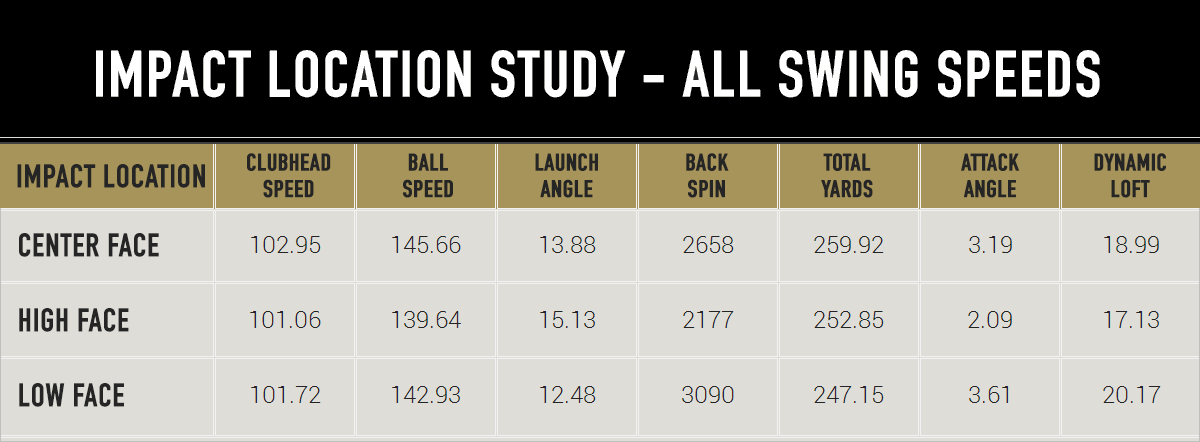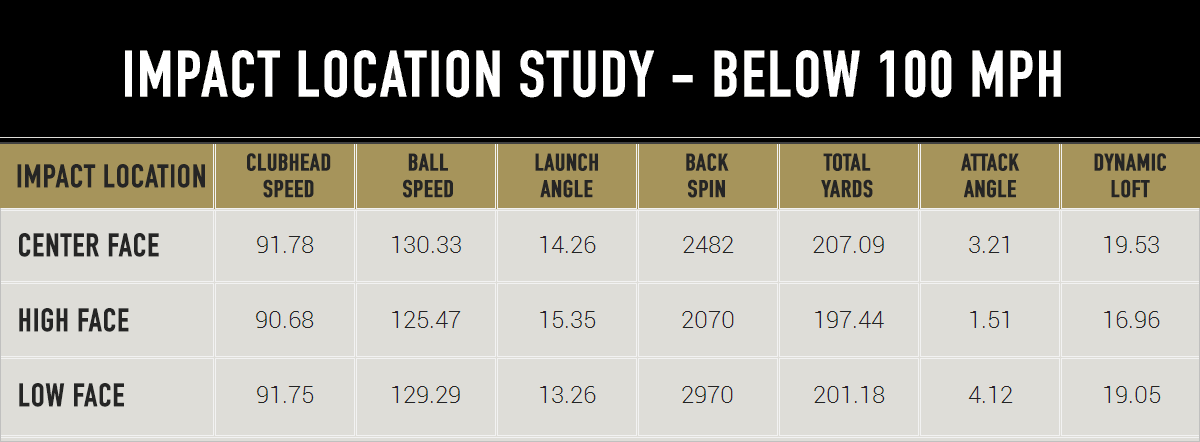Does where you hit the ball on the club face make a difference?
Stupid question. Of course it does.
Many of you know that hitting the ball high on the face decreases spin, while hitting it low on the face increases spin. And even if you don’t understand launch conditions to that degree, you probably didn’t need many reps to figure out that when you miss the center of the face, the ball doesn’t go nearly as far.
We thought it would be interesting to study how exactly impact location affects launch conditions (ball speed, launch angle, and spin rate) and total distance. Along the way, we found some interesting correlations between the dynamics of the swing itself and the actual point of impact.
About the Data
Before we get to the data, here’s a quick recap of where it comes from.
- Data was gathered during this season’s Most Wanted Driver test.
- Included are data points from over 5000 shots (for this sample, it’s actually just under 5700), generated by 20 golfers hitting 25 different drivers.
- Ball data was gathered using Foresight GC2 Launch Monitors, while the head data, including impact location, comes from an attached Foresight HMT unit.
- All testers hit Bridgestone B330-RX Golf Balls.
- For this analysis, we defined the center region as +/- 4.5mm from face center. Arguably this is a generous definition, and we would expect more significant ball speed decreases if we redefined center more narrowly (+/- 2mm for example).
- The header graphic (top) shows the impact pattern from our test, though representative of the actual data, it’s not exactly to scale with the clubface.
IMPACT LOCATION: ALL TESTERS
The chart below includes shots from all testers across all swing speeds of our 2016 Most Wanted Driver Test.
Observations:
- As you would expect, the highest ball speed and total distance resulted from center face shots.
- Ball speed dropped by more than 6 MPH on high face shots, and 2.73 MPH on low face shots.
- Despite lower ball speed, average distance was greater with high face contact (compared to low face contact) due to higher launch and lower spin.
- Note that for launch angle, spin, angle of attack, and dynamic loft, center face contact produced the middle value in the chart.
IMPACT LOCATION: SWING SPEEDS OVER 100 MPH
The chart below contains data from shots initiated with swing speeds of 100MPH or more. The fastest swings included in this data approach 130 MPH.
Observations:
- Ball speed was again greatest on center face contact.
- Low face ball speed for this group was less than 1MPH slower, however, low face shots resulted in substantially less distance (-10.68 yards) due to significantly lower launch and significantly higher spin.
- Benefitting from higher launch and lower spin, and despite lower ball speeds, high face impact produced only 1.04 yards less total distance than center face contact.
- Once again, center face contact produced the middle number for launch angle, spin, angle of attack and dynamic loft.
IMPACT LOCATIONS: SWING SPEEDS UNDER 100 MPH
The chart below contains data from shots initiated with swing speeds of 100MPH or more. The slowest swings included in this data are just under 75 MPH.
Observations:
- No surprise, center face contact again produced the highest average ball speeds.
- For sub-100 MPH swings, low face contact produced ball speeds just over 1 MPH slower, while high face contact resulted in a loss of nearly 5 MPH on average.
- That loss is, in part, due to lower clubhead speed, which we’ll discuss in more detail below.
- Interestingly, among this group, low face contact resulted in 3.74 more yards on average over high face contact.
- This is likely due to the significantly higher ball speeds (+3.82 MPH) from swings resulting in low face contact.
- Swings in the lower end of the group may also benefit from higher spin.
- Note that, once again, center face contact produced the middle number for launch angle, spin, angle of attack and dynamic loft.
Additional Notes:
- There appears to be a correlation between club head speed and impact location – and it holds true for both group averages and individual tester data.
- When high face impact occurred, corresponding swing speeds were, on average, lower than those that resulted in center face and low face contact.
- Also worth noting, high face contact was generally accompanied by a steeper angle of attack and less dynamic loft*.
- For all but our lower swing speed players, low face contact was accompanied by a more upward angle of attack coupled with the presentation of more dynamic loft.
*Loft or static loft is the physical (actual) loft of the club, Dynamic Loft is the actual loft of the club face delivered to the ball at impact.
The Verdict:
At the risk of stating the obvious, impact location matters – and our data supports exactly what we’ve been told for years.
- High Face impact results in higher launch and lower spin; often with a measurable decrease in ball speed.
- Low Face impact results in lower launch with higher spin; often with less drop-off in ball speed.
- The decreased ball speed and distance from non-center contact suggests OEMs have a tremendous opportunity to increase ball speed resiliency over a greater percentage of the face.
- Interestingly, the data suggests that slower swingers may be better off missing low on the face, while higher swing speed players are better served by missing high.
- That said, middle of the face contact is best.


















Waazzupppp
5 years ago
Have to say that the difference in distance was going to be obvious, but the difference in misses between a fast/high location and the slow/low location was very interesting. Good work guys!